| | Tech Tips - Business IT Support Tips
Archive for 2012
Monday, June 11th, 2012
Wouldn’t it be nice to take a picture with your SLR camera and use it just like you would a picture taken on your smart phone? Namely, the ability to share the photograph instantly to social media and upload it anywhere over the internet?
Anyone who has a decent smart phone can take some pretty good pictures “on the run”, but there may be times where you want more control over the exposure than what a phone can provide. Sometimes you might also want to use a tripod for stability or take the type of detailed photograph you just can’t accomplish with a smart phone.
A new, revolutionary product is available that makes all of this possible. It works with any SDHC appliance (non-geek speak: virtually any modern camera) and allows you to send images directly to your smart phone. This is the same size as a standard SDHC memory card and functions in a similar way, but there’s a built in wireless network. If your phone supports wireless networking mode, you can connect directly to the memory card on your camera and can then use your phone to post the images to your favorite social media outlet, such as Google+ or Facebook.
The Eye-Fi 8 GB Mobile XD SDHC Wireless Memory Card has several operating modes which allow you to interact with your computer, laptop, Android or IOS smart phone without using wires. Why wait until you get home to download pictures to your computer for sharing? Use your smart phone to instantly receive the picture and post it to Facebook or any of the other 25 supported imaging sites. It even has an endless picture mode which will remove the picture from the camera automatically once it is uploaded to the computer or smart phone. Your only limitation is the amount of memory on your destination device.
As with any technology, you should research comparability between your specific devices to be sure you get the results you expect. There are some known issues with different cameras that you might want to be aware of. The Eye-Fi User Forums and Frequently Asked Questions page can help. Since the price of of the Eye-Fi is high and there are risks, you may also want to check out reviews before taking the plunge.
Eye-Fi currently offers several products with varied features and prices. Current Eye-Fi SDHC card offerings include:
|
Eye-Fi Connect X2 |
Eye-Fi Mobile X2 |
Eye-Fi Pro X2 |
|
Memory Capacity
|
| 4 GB |
X |
|
|
| 8 GB |
|
X |
X |
|
X2 Engine
|
| Class 6 |
X |
X |
X |
| 802.11b/g/n |
X |
X |
X |
| Endless Memory |
X |
X |
X |
| Direct Mode |
X |
X |
X |
|
Wireless Uploads
|
| Photos and Videos |
X |
X |
X |
| RAW |
|
|
X |
|
Cool Features
|
| Online Sharing |
X |
X |
X |
| Eye-Fi View |
X |
X |
X |
| Hotspot Access |
Upgradable
|
Upgradable
|
X |
| Geotagging |
Upgradable
|
Upgradable
|
X |
| Eye-Fi Premium |
Upgradable
|
Upgradable
|
Upgradable
|
|
|
|
|
So if Geotagging or RAW file is important to you, you’ll have to get the Pro X2 card. If you just need basic point, shoot and transfer, the least expensive Connect X2 is the card for you. All three models are currently available and are priced in ranges from $40.00 to $120.00, depending on where you look.
You can read more about Eye-Fi at http://www.eye.fi

>> Did you like this article? Ping it!
Tags: camera, share, SLR, smart phone, wi-fi, wirelessly
Posted in Tech Club General | No Comments »
Monday, April 30th, 2012
Do you have a need to frequently access folders and files on a laptop or other computer that is not turned on 24/7? If this is you, you’ll know that you usually have to turn on the laptop and wait for it to boot to a state that allows you to access the data. This could be as quick as two minutes or as long as 10 minutes, depending on the age of your hardware. Even worse, if your battery is low and no ac power is available to plug in the laptop you may have to wait even longer.
You don’t have to wait anymore, there is a solution to your data accessibility problems! You can copy those folders and files to a usb memory stick and, not only will you be able to access to the data from another computer, you will also have a “live” backup just in case something ever happens. On a small memory stick with a small amount of data it is possible to perform the data copy operations and keep the data synchronized manually. As your data grows however, the process will eventually become difficult to manage in an effective way. Just the need to answer “Yes” or “No” to every overwrite dialog could make a regular copy operation turn into a nightmare.
Fortunately, Microsoft provides a free tools called SyncToy which will help minimize the time it takes to keep files in sync between folder pairs on your laptop and thumb drive. Download SyncToy here: http://www.microsoft.com/en-us/download/details.aspx?id=15155
You will need the proper download based on your existing operating system, your choices are x64 or x32 bit versions. To find out what version you need, click Start, right click on the computer icon, and select Properties. Half way down the page you’ll see the “System” Header, now find “System Type” and look to see if your system requires 32-bit or 64-bit software. Download and install SyncToy then run it, which will bring up the following screen:
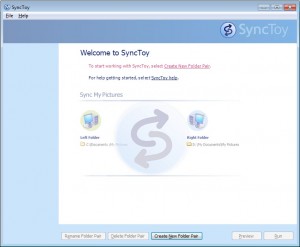
To begin, you need to create a folder pair. This pair is how SyncToy manages keeping your files syncronized between the left and right folders. When you click on the Create Folder Pair button you start the process of joining the folder pairs. It is easiest if you browse to the location for each pair:
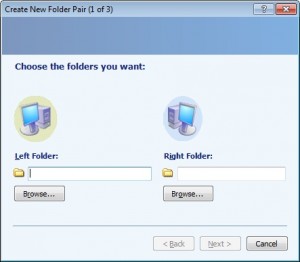
For this example we will use a “Test” folder with the “left” folder on the local hard drive and the “right” folder on a thumb drive. If a folder does not exist on the right folder destination, SyncToy allows you to create the folder as needed. Once you have folders set, you will be given a choice to Synchronize, Echo, or Contribute. For most applications you should Synchronize. You should carfully consider each option to get the best result. Here are the definitions of the options.
Synchronize: New and updated files are copied both ways. Renames and deletes on either side are repeated on the other.
Echo: New and updated files are copied left to right. Renames and deletes on the left are repeated on the right.
Contribute: New and updated files are copied left to right. Renames on the left are repeated on the right. No deletions.
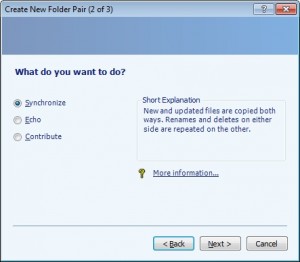 Choose your Sync Now name your pair. This should be a simple name, yet descriptive of the pair.
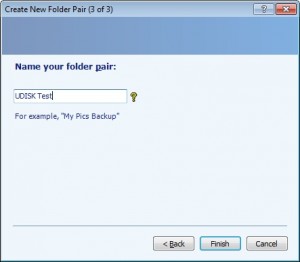 Name your pair That is all there is to creating folder pairs:
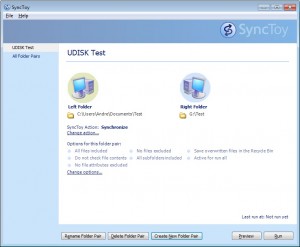 The First Pair The simpler you keep your pairs, the easier it will be to maintain them. Now you simply need to run the pair(s) as needed, or put them on a schedule, but that is a topic for a future blog post.
my PC Techs provides expert computer consultants to your Arizona business. Let us help your business save money and increase productivity. Call today (602) 456-0150 for a free consultation.
Tags: 32, 64, accessibility, backup, bit, browser, computer, contribute, copy, create folder pair, data, deletes, echo, files, folder pair, folder pairs, folders, laptop, left, memory stick, microsoft, overwrite, rename, renames, repeated, right, synchronize, synctoy, thumb drive, tool
Posted in Tech Club General | No Comments »
Friday, April 13th, 2012
 A small to medium sized business today needs to move at the speed of light in order to remain competitive. All too often, employee productivity is tied directly to the responsiveness of the office internet connection. With remote workers, social media, online apps, cloud databases, email, and other web based technologies forming the hub of a company’s communication system it is critical to maximize internet speed in order for work to be completed quickly. A small to medium sized business today needs to move at the speed of light in order to remain competitive. All too often, employee productivity is tied directly to the responsiveness of the office internet connection. With remote workers, social media, online apps, cloud databases, email, and other web based technologies forming the hub of a company’s communication system it is critical to maximize internet speed in order for work to be completed quickly.
Internet speeds have come a long way from the days of Dial-up and many different technologies have emerged to help connect your small to medium sized business computers to the Cloud. The most common of these technologies for an office include DSL, Dedicated T1, Cable, and Cellular. With each differing technology comes a range of different features, varying reliability, and different levels of performance, price, customer service and ease of use.
When the time comes to evaluate an internet provider for your office and business technology needs, it is important to weigh everything together. The overall speed, price, reliability, provided features, and even the reputation of the service providers are important when it comes to making the final decision. Here is a general overview of the main differences between various types of data technologies for your office:
Rated by Speed from Slowest to Fastest in a Typical Environment
- DSL (usually the slowest)
- Cellular
- T1
- Cable Broadband (usually the fastest)
Average Prices from Least to Most Expensive
Average Reliability from Least to Most Reliable
While the least expensive choice for business solutions is DSL, it is usually the slowest speed which can have a crippling effect on workplace productivity. Whenever taking speed into consideration, it is important for a professional to evaluate the number of computers, devices, and what they will be used for. That information can be compared to speed ratings for the various types of internet available.
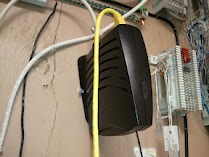 This is a standard cable modem Another important point to evaluate with intended usage is the need for 24×7 connectivity. In some cases, for example if an email server or web server is part of the office technology deployment, it is more important to lean towards the more reliable solutions to avoid any disruption in services. The most reliable and expensive solution is a dedicated T1. A T1 maintains a connection to the Cloud at a constant speed with 99.99% up-time. While this is the most expensive choice, it has the highest probability of working when you need it.
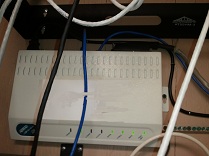 T1 TDM router If mobility is what you’re after, you’re going to want to take a look at cellular. Cellular data technologies allow you to take your work with you wherever you go. And last but not least, the best bang for your buck overall is Cable broadband. This is a great choice if you need a lot of speed at a great price.
Are you moving offices, looking at starting up a new office, or just need to upgrade your existing office? my PC Techs is a locally owned, Phoenix, Arizona based technology consulting firm. We have special connections to all of the big data providers in the area, including Cox, Integra, Verizon, and Centurylink (formerly Qwest). We can help your business evaluate speed, price, and reliability and decide between DSL, T1, Cable, or Cellular. Most importantly, we will help you get the best price and make the installation easy for you.
Speed up your office and get more work done in less time for less money. That’s what we do at my PC Techs. We help your business increase productivity, save time, and save money. Don’t lose another minute of productivity due to slow or unreliable Internet access! Give our experts a call today @ (602) 456-0150 for a free consultation and find out for yourself why our clients rave about our superior service and affordable prices.
Tags: business, cable, cellular, centurylink, consultant, cox, data, dsl, fast, integra, internet, internet access isp speed, office, performance, price, qwest, reliability, speed, t1, verizon
Posted in Tech Club General | 1 Comment »
Sunday, March 4th, 2012
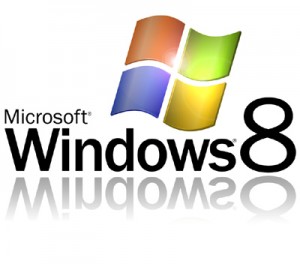 The Windows 8 Consumer Preview is now available to download, giving you the chance to try out the latest operating system from Microsoft. Whether you have a logo PC or you’ve built your own PC, the recommendations for the Consumer Preview include: The Windows 8 Consumer Preview is now available to download, giving you the chance to try out the latest operating system from Microsoft. Whether you have a logo PC or you’ve built your own PC, the recommendations for the Consumer Preview include:
– 1 GHz or faster processor
– 1 GB RAM (32-bit) or 2 GB (64-bit)
– 16 GB hard disk space (32-bit) or 20 GB (64-bit)
– DirectX 9 graphics device with WDDM 1.0 or higher
This setup gets you going with Windows 8 such that it is functionally equivalent to Windows 7, and as we have talked about previously, you should see measureable improvements in performance in a number of dimensions with a system at this level.
One new element to Windows 8 is the requirement that Metro style applications have a minimum of 1024×768 screen resolution, and 1366×768 for the snap feature. If you attempt to launch a Metro style app with less than this resolution (e.g. 800×600, 1024×600) you will receive an error message.
Since the software is in everyone’s hands now, we will follow up with a more detailed blog post where you can learn more about the work we did for scaling across multiple resolutions and why this is a requirement in order to make sure developers can easily build applications that scale well across resolutions. We chose to allow Windows 8 to install even when a system doesn’t meet this requirement because, even without Metro style applications, your Windows 7 workloads on these PCs will improve and you can benefit from all the other features of Windows 8, including enhancements to the desktop. We have made sure that Start and Settings all scale well on 800×600 resolution screens.
Visit the offical Windows 8 Consumer Preview download page for more details.
>> Did you like this article? Ping it!
Tags: consumer preview, download, microsoft, system requirements, windows 8
Posted in Tech Club General | No Comments »
Wednesday, February 15th, 2012
There have been countless articles written to help you with reducing temporary files that clutter your hard drive. Windows performs cleanup for most of these files under normal circumstances, but control over the process is limited. To gain more control over these files, you can use CleanMgr as part of a normal monthly maintenance cycle.
In a modern Windows OS, when you click Start/Accessories/System Tools/Disk Cleanup you will note a dialog which will eventually present you with choices of files to remove from your computer. These are left over files from various activities and will look something like this:
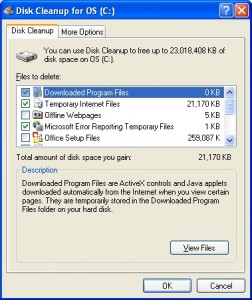 Disk Cleanup can assist you in removing no longer needed files Now you are able to select the categories you want to remove, for example, Temporary Internet Files, Microsoft Error Reporting Temporary Files, Recycle Bin, Temporary Files, WebClient/Publisher Temporary Files, etc. Note these are all temporary files. There are also other categories you should normally never select. These include Office Setup Files, Log Files, Compress Old Files and Catalog files for the Content Indexer. Please note Windows Vista and Windows 7 users will have more options available.
If this is the first time you have ran CleanMgr (Disk Cleanup), the initial scan process could take quite some time. These scan’s may take in excess of an hour. Microsoft had provided a way to streamline this process through preferences, but you have to use the Command Prompt to take advantage of it.
To get started we’ll need to use the CMD prompt. Alternatly, you can “Run” a command from the “Start Button” this will work too.
Let’s start with the CMD prompt:
For Windows XP click Start/Run/CMD
For Windows 7 click Start/All Programs/Accessories/Command Prompt
This will open a Command Console allowing you to type in the following command:
cleanmgr.exe /sageset:99
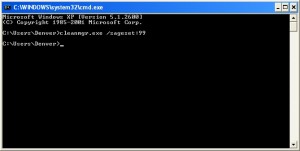
Running CleanMgr from the Command Prompt
This will bring up a new Disk Cleanup Settings window
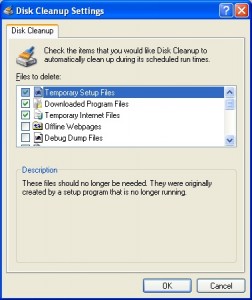
On Windows XP computers, you should usually select the following categories: Temporary Setup Files, Downloaded Program FIles, Temporary Internet Files, Microsoft Error Reporting Temporary Files, Old Chkdsk files, Recycle Bin, Temporary Remote Desktop files, Temporary Files, WebClient/Publisher Temporary Files, Catalog files for the Content Indexer. Optionally you could select Debug Dump Files and Offline Webpages as well. You should almost NEVER select Office Setup Files.
On Windows 7 computers, you should usually select the following categories: Temporary Setup Files, Downloaded Program Files, Temporary Internet Files, Debug Dump Files, Old Chkdsk files, Recycle Bin, Service Pack Backup Files, System error memory dump files, System error minidump files, Temporary Files, Temporary Windows installation files, Thumbnails, Files discarded by Windows upgrade, Per user archived Windows Error Reporting Files, System archived Windows Error Reporting Files
Once you have made your selections, Click OK.
Now that you have saved your settings, run the following command:
cleanmgr.exe /sagerun:99
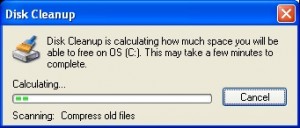 - The Sagerun Switch
This process could take some time to complete and will run on all attached drives. So if you have network drives or external drives you do not want included, be sure to disconnect or remove these drives.
For more information about using CleanMgr from the command line please reference:
http://support.microsoft.com/default.aspx?scid=kb;en-us;Q315246 (for Windows XP)
http://windows.microsoft.com/en-us/windows7/Delete-files-using-Disk-Cleanup (For Windows 7)
my PC Techs provides expert computer repair and computer consulting services to the Phoenix metro area. For more information or to schedule an appointment please call (602) 456-0150.
Tags: cleanmgr, cleanup, computers, disk cleanup, files, hard drives, temporary files, windows
Posted in Tech Club General | No Comments »
WE WORK HARD FOR YOU, BUT DON'T JUST TAKE OUR WORD FOR IT!
We've helped over 1,000 satisfied businesses throughout the Phoenix valley, click here to view some of their testimonials:

©2010 my PC Techs is owned and operated by Leo Polus, L.L.C., concept by Andre Morris |
| |







 A small to medium sized business today needs to move at the speed of light in order to remain competitive. All too often, employee productivity is tied directly to the responsiveness of the office internet connection. With remote workers, social media, online apps, cloud databases, email, and other web based technologies forming the hub of a company’s communication system it is critical to maximize internet speed in order for work to be completed quickly.
A small to medium sized business today needs to move at the speed of light in order to remain competitive. All too often, employee productivity is tied directly to the responsiveness of the office internet connection. With remote workers, social media, online apps, cloud databases, email, and other web based technologies forming the hub of a company’s communication system it is critical to maximize internet speed in order for work to be completed quickly. 

 The
The 









